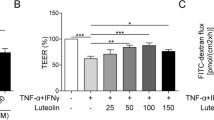Abstract
The influence of capsaicin processing on human intestinal cell line Caco-2 was examined by measuring transepithelial electrical resistance (TER). There was an increase in permeability at high concentration (200 to 500 μM) of capsaicin, and the effect was inhibited by pretreatment of capsazepine, which is a competitive antagonist of the vanilloid receptor 1 (VR1). LDH-activity as well as changes in intracellular Ca2+ were determined to know whether or not capsaicin affected TER activity through its influence on the tight junction. We also determined the expression of the VR1-like protein on Caco-2 cells in time-dependent manner by western blotting using vanilloid receptor (VR1) antiserum. Our results showed that the permeability increase by capsaicin was through binding to VR1-like protein of Caco-2 cells.
Similar content being viewed by others
References
Aase F & Arne S (1991) Dantrolene prevents glutamate cytotoxicity and Ca2+ release from intracellular stores in cultured cerebral cortical neurons.J Neuroche56:1075–1078.
Arpad S & Peter MB (1999)Vanilloid (Capsaicin) Receptors and mechanisms.Phar Rev51:159–211.
Jensen-Jarolim E, Gajdzik L, Haberl I, Kraft D, Scheiner O & Graf J (1997)Human nutrition and metabolism.J Nutr6:577–581.
Gronbech JE & Lacy ER (1994) Substance P attenuate gastric mucosal hyperemia after stimulation of sensory neurons in the rat stomach.Gastreonterology106:440–449.
Hashimoto K, Kawagishi H, Nakayama T & Shimizu M (1997) Effect of capsianoside, a diterpene glycoside, on tight-junctional permeability.BBA1323:281–290.
Takahata K, Chen X, Monobe K-I & Tada M (1999) Growth inhibition of capsaicin on Hela cella is not mediated by intracellular calcium mobilization. Life Sciences64:165–171.
Michael JC, Rosen TA, Tominaga M, Brake AJ & Julius D (1999) A capsaicin-receptor homologue with a high threshold for noxious heat.Nature398:430–441.
Michael JC, Schumacher MA, Tominaga M, Rosen TA, Levine JD & Julius D (1997) The capsaicin receptor: a heat-activated ion channel in the pain pathway.Nature389:816–824.
Platel K & Srinivasan K (1996) Influence of dietary spices or their active principles on digestive enzymes of small intestinal mucosa in rats.Int J Food Nutr47: 55–59.




